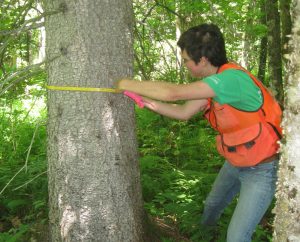Mitchell Center Student Worked to Map, Protect Threatened Black Ash Stands
 Black ash trees are in the crosshairs of the emerald ash borer (EAB) with the deadly insect knocking on the door of Northeastern coastal states. Kara Costanza concentrated her studies on the precious tree species, working on multiple preemptive solutions.
Black ash trees are in the crosshairs of the emerald ash borer (EAB) with the deadly insect knocking on the door of Northeastern coastal states. Kara Costanza concentrated her studies on the precious tree species, working on multiple preemptive solutions.
Costanza, a student with the former Sustainability Solutions Initiative (SSI), studied black ash stands in Maine and northern New York, looking at the biology and ecology of the species about which little is known. The threat from EAB, which kills ash trees by tunneling into the wood, is potentially devastating. Scientists have predicted the insect could be in Maine in one to two years.
Black ash is the most important basket-making resource for Maine’s Wabanaki tribes. The baskets are the center of a spiritual tradition thousands of years old and a source of income for the tribes. On an ecological level, black ash is one of the few species that can colonize wetlands, which support a variety of ecosystems. Many black ash wetlands have been devastated in the Midwest where EAB has killed upward of 100 million ash trees
“Based on the important ecological niche that black ash fills and the socio-economic role this species plays for Native American tribes, it is essential to identify and map high-quality sites where black ash grows so the species may be better monitored and protected from environmental stressors,” Costanza said.
In her time working with SSI’s Emerald Ash Borer team, she created a Geographic Information System (GIS) map with multiple layers, each of which represents characteristics deemed critical for healthy, basket-quality black ash stands. The map shows where high-quality stands are likely to exist in Maine and northern New York.
Through SSI, Costanza had the opportunity to work with faculty and students from a number of different disciplines in addition to stakeholder partners – an experience she found illuminating.
“Working with the SSI team has been extremely beneficial. They’ve provided access to other research teams and specialists, which would have otherwise been difficult to achieve. Working with such a large collaborative has been a great experience. The SSI group is a great example of how science will likely progress in the future: by bringing together researchers from multiple disciplines to put together the pieces of a larger puzzle,” Costanza said.
As the SSI EAB project wraps up, Costanza will start work on her PhD in the School of Forest Resources studying white pine. Her advisor at UMaine is Bill Livingston, Associate Professor in the School of Forest Resources and a member of the EAB team.
